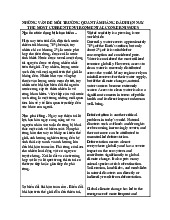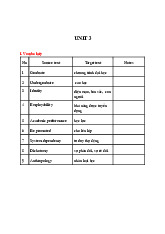






Preview text:
lOMoAR cPSD| 47882337 Unit 1_ Population
Part 1: English - Vietnamese Translation Exercise 1
- human population: dân số thế giớiGlobal, world, local, national + population
working (working-age) population: dân số trong độ tuổi lao động
Ageing (elderly) population vs population ageing: dân số già vs già hóa dân số
- human species/ race/ beings: loài người/ nhân loại
Humankind/humanity/mankind
- starvation/ famine/ hunger: nạn đóihunger for freedom: khao khát tự do
starvation wages: đồng lương chết đói
- burgeoning population: dân số tăng nhanh không ngừng (dân số bùng nổ) -
persistent/ unrelenting malnutrition and starvation: tình trạng suy dinh dưỡng
và nạn đói triền miên (dai dẳng)
- projected global population: dân số toàn cầu/ loài người ước tính
- conceptual contrast: bất đồng quan điểm
- grow/ increase exponentially: gia tăng theo cấp số nhân (số mũ)
- grow/ increase arithmetically: gia tăng theo cấp số cộng
- profligate childbearing: tình trạng sinh đẻ không có kế hoạch
- to check/control/curb/limit/resteict profligate childbearing: kiểm soát mangthai ngoài ý muốn
- abstinence: kiêng khem, hạn chế, tiết chế (tránh thai in this context only)
Abstinence from sth: kiêng, tránh
Eg: abstinence from red meat
- inequitable (food) distribution: phân bố lương thực không đồng đều
Inequitable: liên quan đến phân phối, phân bố (lương thực)
Uneven: nói đến việc pt kte k đồng đều do đk tự nhiên/ vị trí (thủ đô/ nông thôn)
Unfair : liên quan đến moral judgement
- per capita food production: sản lượng lương thực trên đầu ngườiOr food production per capita
Income per capita / per capita income
- the rank of the hungry: số người đói
- food-producing capacity: khả năng sản xuất lương thực
- sustainable balance:sự cân bằng bền vững
Balance >< imbalance (n) Gender balance
- rapid population growth: tăng trưởng dân số nhanh chóng/ dân số tăng trưởngnhanh chóng
- environmental degradation: tình trạng suy thoái môi trường
- growing/ increasing hunger: nạn đói gia tăng
- life-threatening cycle: vòng xoáy đe dọa đời sống và tính mạng cng
- population policy: chính sách dân số lOMoAR cPSD| 47882337
- National Committee for Population and Family Planning: Ủy Ban Quốc giavề
Dân số và Kế hoạch hóa gia đình
- intra-iterine device (IUD): vòng tránh thai
- oral contraceptive (OC): viên uống tránh thai
- sterilisation: phương pháp triệt sản (for man only)/ thắt ống dẫn tinh
- to be fitted with an intra-uterine device: đặt vòng tránh thai
- to remove an intra-uterine device: tháo vòng tránh thai
- to avoid pregnancy: tránh thai
- exploding/ booming population: bùng nổ dân số
- to carry on family name: nối dõi tông đường, duy trì nòi giống
- the Minister in charge of population and family planning: bộ trưởng phụ
tráchdân số và kế hoạch hóa gia đình
- to curb/ control/ rein/ check population boom/ explosion: kiểm soát việc bùngnổ dân số
- to promote family planning: thúc đẩy kế hoạch hóa gia đình
- couples in child-bearing years: các cặp vợ chồng trong độ tuổi sinh
sảnreproductive health: sức khỏe sinh sản
- modern contraceptives: các biện pháp tránh thai hiện đại
- birth control/ contraceptive pills: viên uống tránh thai
- the United Nations Population Fund (UNFPA): Quỹ dân số Liên hợp quốc- the
world’s seventh-fastest-growing nation: quốc gia đứng thứ 7 trên thế giới về gia tăng dân số
- to make considerable progress in Family Planning: có những tiến bộ đáng
kểtrong công tác kế hoạch hóa gia đình
- fertility/ birth rate: tử lệ sinh
- mortality/ death rate: tỷ lệ tử
- census: sự điều tra dân số
- annual population growth rate: tỉ lệ gia tăng dân số hằng năm Bài dịch
Text 1: World population overview
Tổng quan về dân số thế giới Lester R. Brown
Vào khoảng giữa 24 tháng 6 và 11 tháng 7 năm 1987, dân số Trái Đất đạt
mức 5 tỷ người. Tuy nhiên, 200 năm trước đó, khi dân số thế giới mới chỉ khoảng
hơn một tỉ, các nhà kinh tế chính trị như Malthus và David Ricardo đã dự đoán
rằng loài người sẽ sinh sôi đến mức đẩy chính mình vào nạn đói. Dẫu vậy, bất
chấp những lời tiên đoán đoán này, dân số thế giới vẫn tiếp tục gia tăng, nhưng
nguồn cung cấp lương thực cũng tăng lên. 2 quan điểm đối lập nhau liên quan
đến việc dân số tăng nhanh có mức độ ảnh hưởng như thế nào đến nguồn cung
cấp lương thực. Quan điểm thứ nhất cho rằng nếu dân số không được kiểm soát,
tình trạng suy dinh dưỡng và nạn đói triền miên sẽ trở thành một vấn đề không
thể tránh khỏi đối với phần lớn dân cư thế giới. Quan điểm thứ hai lại cho rằng, lOMoAR cPSD| 47882337
ngay cả khi dân số thế giới được dự đoán là chạm mốc 10 tỷ người vào năm 2070
thì vẫn sẽ có đủ lương thực cho tất cả mọi người.
Sự bất đồng quan điểm giữa các nhà kinh tế học và nhà sinh thái học được
thể hiện rõ ràng nhất trong cách họ nhìn nhận gia tăng dân số. Khi đánh giá tác
động của gia tăng dân số, các nhà kinh tế học thường không coi nó như một tai
họa đặc biệt nghiêm trọng. Theo quan điểm của họ, nếu nền kinh tế của một quốc
gia tăng trưởng 5% mỗi năm và dân số tăng trưởng 3% 1 năm, thì mức sống cũng
sẽ tăng trưởng ổn định/đều đặn ở mức 2%. Nếu như chỉ dựa vào các biến số kinh
tế thì có thể suy diễn rằng tình hình này vẫn sẽ được duy trì trong tương lai.
Mối quan tâm về ảnh hưởng của dân số không hề mới. Đã gần 2 thế kỷ
trôi qua kể từ khi Malthus xuất bản luận thuyết nổi tiếng của mình, trong đó ông
đưa ra quan điểm rằng dân số thế giới có xu hướng tăng theo cấp số nhân khi sản
xuất lương thực tăng theo cấp số cộng. Ông cho rằng, nếu như không kiểm soát
việc sinh đẻ bừa bãi, hơn hết là thông qua các biện pháp tránh thai, thì nạn đói
chắc chắn sẽ xảy ra. Malthus đã sai lầm khi không dự đoán được tiềm năng to
lớn của các công nghệ tiến bộ trong việc tăng năng suất đất trồng. Tuy nhiên, ông
đã dự đoán đúng những khó khăn trong việc gia tăng sản lượng lương thực ngang
bằng với tốc độ gia tăng dân số. Ngày nay, hàng trăm triệu người trên toàn thế
giới đang đối mặt với cảnh đói, một phần là bởi vì sự phân bố lương thực không
đồng đều, nhưng phần lớn/ chủ yếu là do sự sụt giảm trong việc sản xuất lương
thực bình quân đầu người. Và từ những năm 90, số lượng người đói đang ngày càng gia tăng.
Malthus quan tâm về mối quan hệ giữa sự gia tăng dân số và khả năng sản
xuất lương thực của thế giới. Hiện nay, chúng ta đều biết rằng gia tăng dân số và
các hoạt động kinh tế có ảnh hưởng lớn tới nhiều khả năng tự nhiên khác, ví dụ
như khả năng hấp thụ chất thải của trái đất. Xét theo mức độ ô nhiễm bình quân
theo đầu người nào, nhiều người sẽ gây ra nhiều sự ô nhiễm hơn. Do hành động
xả thải rác công-nông nghiệp vượt qua khả năng tự phân hủy chất thải của hệ
thống tự nhiên, cho nên sự tích lũy các nguyên vật liệu độc hại ngoài môi trường
bắt đầu ảnh hưởng xấu tới sức khỏe con người.
Nhìn chung, những năm 80 không phải là một thập kỷ thành công đối với
những nỗ lực nhằm đạt được sự cân bằng bền vững giữ con người vàcác nguồn
tài nguyên thiên nhiên. Sự gia tăng dân số không ngừng và sự lan rộng của suy
thoái môi trường đã kìm hãm hàng trăm triệu người trong vòng luẩn quẩn của sự
giảm thu nhập và nạn đói gia tăng. Cùng với số lượng người đang mắc kẹt trong
vòng xoáy đe dọa đời sống con người tăng lên mỗi năm, thế giới có lẽ sẽ sớm
nghiêm túc suy xét đến hậu quả của những năm mà chính sách dân số bị xao lãng.
Part 2: Vietnamese - English Translation
- dân số tăng nhanh: burgeoning/ booming/ exploding population, rapid
population growth, booming population, rapid increase in population, - vấn đề
nan giải:dilemmas (2 options chọn 1)/ unresolved issues/ challenging
problems/ knotty/thorny problems/ hard-solving/ hard-to-solve problem Không
dùng các từ như insoluble, insuperable, insurmountable
- làm trầm trọng thêm: deteriorate/ exacerbate/ aggravate/ worsen lOMoAR cPSD| 47882337
- sự hủy hoại môi trường và sinh thái: environmental and ecologicaldestruction/ deterioration/ damage
- khai thác cạn kiệt tài nguyên thiên nhiên: natural resource depletion/ toexhaust/
use up/ drain/ deplete natural resources
- nạn khan hiếm lương thực: food scarcity
An ninh lương thực: food security
An toàn vệ sinh thực phẩm: food safety and hygience
Ngộ độc thực phẩm: food poisoning
- sự nghèo đói: (hunger and) poverty
Xóa đói giảm nghèo: hunger eradication and poverty reduction (HEPR)
People living in extreme poverty
- mù chữ: illiteracy
Even if you are a computer illiterate you should be able to follow these simple instructions.
Nếu bạn không biết sử dụng máy tính, bạn nên làm theo các chỉ dẫn sau.
- thất nghiệp: unemployment
Trợ cấp thất nghiệp: unemployment benefit(s)
Double-digit unemployment: thất nghiệp ở mức hai con số
- những bệnh truyền nhiễm nguy hiểm đang lan tràn: Dangerous
infectiousdiseases are spreading / the spread of dangerous infectious diseases/ Spreading/
rampant dangerous contagious/ infectious disease Contagious
smile: nụ cười có sức lan tỏa
- quá trình phát triển kinh tế-xã hội: socio-economic development
- phát triển bền vững: sustainable developmentSustainable development goals (SDGs)
- việc đào tạo và phát triển nhân lực: human resources training anddevelopment
- tổng thu nhập quốc dân: Gross National Product(GNP)
GDP:tổng thu nhập quốc nội (trong lãnh thổ): measure the value of goods
and services produced within a country’s borders, by citizens and noncitizens alike
GNP:giá trị mà tất cả giá trị mà người dân quốc gia đó mang lại:
measure the value of goods and services produced by a country’s citizens, both
domestically and abroad
GDP is the most commonly used by global economies.
- sống dưới mức nghèo khó: live below/under the poverty line/ povertythreshold/ poverty limit/ breadline
Sống ở mức cận nghèo: live near the poverty line
Live/ to be + on/ close to/ below the poverty line
- làn sóng di dân từ nông thôn ra thành thị: rural-to-urban migrationwave/flow/stream
The wave of migration from rural to urban areas
Migrate: talking about the actual process of moving lOMoAR cPSD| 47882337
Immigrate:point of arrival
Emigrate:looking at the point of departure
Phân biệt dựa vào point of view
Eg: People migrate for better education, security, job opportunities.
- sự quá tải về dân số: overpopulation
- các bệnh về đường hô hấp: respiratory diseases
Bệnh mãn tính vs bệnh cấp tính: Chronic diseases vs acute diseases
Bệnh di truyền: Genetic/ hereditary/ inherited diseases
Bệnh bẩm sinh: congenital disease
Bệnh nghề nghiệp: occupational disease
Nhiễm bệnh: catch/ contract/ get + disease
- diện tích rừng: forest area
- suy thoái tầng ozone: ozone layer degradation/ depletion
- đe dọa sự tồn tại của nhiều loài động vật: threaten the existence of manyanimal species
- tỷ lệ người mù chữ: illiteracy rate
- các dịch vụ y tế: medical/ health(care) services
- tỷ lệ mù chữ trong nữ giới: female illiteracy rate
- cái vòng luẩn quẩn: a vicious circle
- một địa vị xã hội thấp kém: an inferior/low social status
- chương trình hành động: Program of Action
- Hội nghị Quốc tế về Dân số và Phát triển (ICPD): International Conferenceon Population and Development
- các hoạt động tuyên truyền vận động về dân số: populationadvocacy/population awareness campaign
- huy động các nguồn lực và sự hỗ trợ cần thiết: mobilize necessary resourcesand assistance
- ổn định mức tăng trưởng dân số: stabilize population growth rate
- một loạt các sáng kiến về dân số và phát triển: a series/ wide range ofpopulation
and development initiatives - lồng ghép: intergrate sth into/with sth
- sức khỏe sinh sản: reproductive healthNhân viên y tế: health worker
- Học việc Chính trị Quốc gia Hồ Chí Minh: Ho Chi Minh National Academyof Politics
- Ủy ban Các vấn đề Xã hội của Quốc hội: National Assembly’s Committee forSocial Affairs
- Ủy ban Dân số và Kế hoạch hóa Gia đình: National Assembly’s Committeefor
Population and Family Planning - Các Tổ chức Đoàn thể: mass organizations
- Các cơ quan truyền thông đại chúng: mass media agencies
- Nâng cao hơn nữa ý thức và sự hiểu biết về: further
/improve/raise/enhanceawareness and understanding of/ about sth - mối quan hệ qua lại giữa dân số và phát triển:
theinterrelationship/interrelation/mutual relationship between population and development Bài dịch lOMoAR cPSD| 47882337 Text 3
Burgeoning population growth is posing quite a few hard-solving issues
Rapid population growth is exacerbating hard-solving problems for
human being, including the environmental and ecological destruction, natural
resource depletion, food scarcity, poverty and hunger, illiteracy, unemployment,
along with spreading dangerous infectious diseases.
Population is currently a concern for many countries because it directly
impacts on the socioeconomic development of each nation. In the current
situation/ present context, for sustainable economic development/ to sustain
economic development, it is important for countries to (attach better/greater
importance on)/ (focus more on) population issues/ countries should focus more
on population issues, especially in terms of human resources training and development.
According to the World Bank (WB), although the Asia-Pacific’s
population currently accounts for over half of the world population, its GNP only
represents 1/4 of the global Gross National Product (GNP). According to the
Asian Development Bank (ADB), the number of people living below the poverty
line currently constitutes 49% of the South Asia’s population and 30% of the global ones.
In recent years, the urbanization in Asia has been occurring/taking place
at a much faster rate at 2 to 5 times faster than the case of that in Europe. This
has resulted in a wave of rural-to-urban migration. This has led to a substantial
increase in the population of many Asian metropolises/big cities/ major/large
cities/ mega cities. Currently, the population has reached 13 million in Calcutta
(India), 12 million in Seoul (South Korea), 12 million in Jakarta (Indonesia), and so on.
Overpopulation in many Asian cities has made environmental issues more
pressing and urgent than ever before. In Bangkok (Thailand), air pollution has
resulted in a sharp rise/ significant increase respiratory diseases among population.
Meteoric growth of population has also caused a noticeable depletion/
reduction in natural resources, particularly in forest area. Recently, the areas of
damaged and burnt forest in Thailand, Indonesia, the Philippines and Myanmar
have exceeded 3.000 square kilometers, directly influencing/ exert on the
national population’s health. Additionally, this has contributed to ozone layer
depletion, and caused numerous spells of droughts, floods, hail, storms (cyclone
is ok) and threatened/ posed a threat to the existence of many animal species.
Besides, rapid population growth has led to an increase in the illiteracy
rate, and inadequate access to health services. Currently, there are approximately
up to 600 million illiterate women worldwide. The female illiteracy rate in Asia
is also relatively high, ranging from 50 to 75%.
The most crucial tool for women to break free from the vicious circle of
low social status, poverty and large families is education, which the United
Nations considers paramount in implementing family planning. lOMoAR cPSD| 47882337
After the International Conference on Population and Development’s
Program of Action was approved/passed/ adopted, people paid serious attention/
had properly concerned about the population advocacy. These activities aimed to
mobilize necessary resources and support for stabilizing population growth rate
through a series of initiatives of population and development .
Therefore/ Thus/ Hence/ As a result/ Consequently/ Accordingly, the
Vietnamese Government is trying to integrate population issues, sustainable
development and reproductive health into these activities of various
organizations such as Ho Chi Minh National Academy of Politics, National
Assembly’s Committee for Social Affairs, National Assembly’s Committee for
Population and Family Planning , and mass media agencies.
Population advocacy efforts will further enhance awareness and
understanding of the interrelationship between population and development. It
will bring forth support and leadership commitment for essential initiatives
targeted at achieving sustainable quality of life for all.
The fate of this planet is presenting a resolute choice each nation and the global community.



